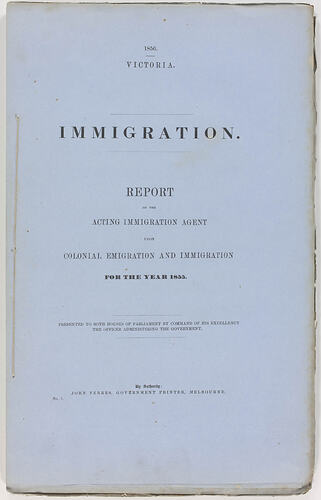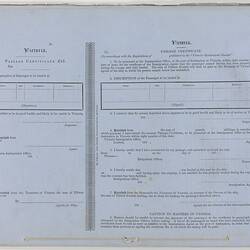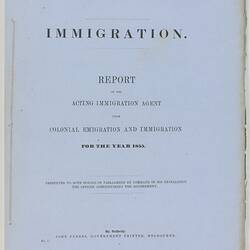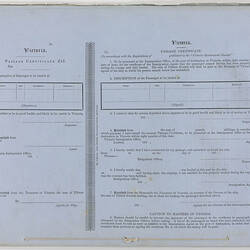Summary
Document tabled in the Parliament of Victoria for the Acting Immigration Agent in 1856 entitled 'Immigration. Report of the Acting Immigration Agent upon Colonial Emigration and Immigration for the Year 1855'. This Report outlines a range of issues and statistics relating to immigration and emigration in Victoria for 1855, including the following: numbers of arrivals and departures; nature of immigration (assisted and unassisted) and numbers in each category; nature and length of ship voyages and passenger health; statistical breakdown of gender and origin of immigrants; recommendations for immigrant selection, management and dispersal (emphasising agricultural and domestic workers); and proposals for changing the systems of administering funds. The substantial appendices presents detailed statistics on assisted and unassisted immigration and emigration.
Physical Description
Foolscap size, 64 page blue paper document, typed on all sides and spine sewn.
Significance
These documents illustrate the range of issues facing colonial immigration administrators such as immigrant selection, temporary accommodation and funding assisted passages. The paper on Immigrant Homes provides a fascinating insight into what accommodation was provided for homeless migrants in the immediate gold rush period, including a reference to Caroline Chisholm's Family Colonization Loan Society and a hospital established at Canvas Town. Reports relating to immigrant selection demonstrate issues of lack of agricultural and domestic workers - a perennial concern of colonial, state and federal governments - and perceived skills gaps in specialized agricultural pursuits. The Despatch relating to Chinese immigration to Western Australia, while not specifically about Victoria, does highlight the colonial anxiety regarding Chinese immigrants which led to the virtual banning of immigration from China in 1888.
This collection also shows the range of colonial and British agencies involved in immigration/emigration policy and administration, such as Colonial Land and Emigration Office and the Immigrant Agent in London and the Dept of Trade and Customs. In the nineteenth century immigration policy was controlled primarily by the British Parliament. Legislation such as the Passengers Act of 1855 attempted to establish uniform controls for migration throughout the British Empire and to ensure the safe passage of migrants. From the 1840s until the 1870s the British Colonial Land and Emigration Commission oversaw migration policy for the Empire. Immigration offices and agents in Great Britain and other countries worked at a local level to process applications and arrange voyages. Immigrants filled in application forms and attended interviews and under the British Passengers' Act of 1855 they also had to submit to physical inspections.
Colonial parliaments had a Printing Committee which decided which Parliamentary business would be printed. It was the law that printed documents were to be available from the Government Printer to the public for cost price . Typically, in the 1860s there would be a print run of around 560 copies and these were distributed to Parliamentarians, their Secretaries, the heads of relevant Departments and some Public Libraries/Mechanics Institutes. The remainder were held by the Government Printer for Public sale with the price often printed on the document. By the 1900s most documents & reports had a print run of around 800. Prior to the 1890s, most papers were printed on high 'rag' content paper which has ensured that they have usually survived in very good condition.
More Information
-
Collecting Areas
-
Acquisition Information
Purchase
-
Printer
John Ferres, Government Printer, Melbourne, Victoria, Australia, 1856
-
Authorised By
-
Inscriptions
Text, front cover: 1856/VICTORIA/IMMIGRATION/REPORT/OF THE/ACTING IMMIGRATION AGENT/UPON/COLONIAL EMIGRATION AND IMMIGRATION/FOR THE YEAR 1855.
-
Classification
-
Category
-
Discipline
-
Type of item
-
Overall Dimensions
21.8 cm (Width), 35 cm (Height)
-
Keywords
Assisted Immigration, Government Policies, Immigration, Immigration Policies, Settlement




